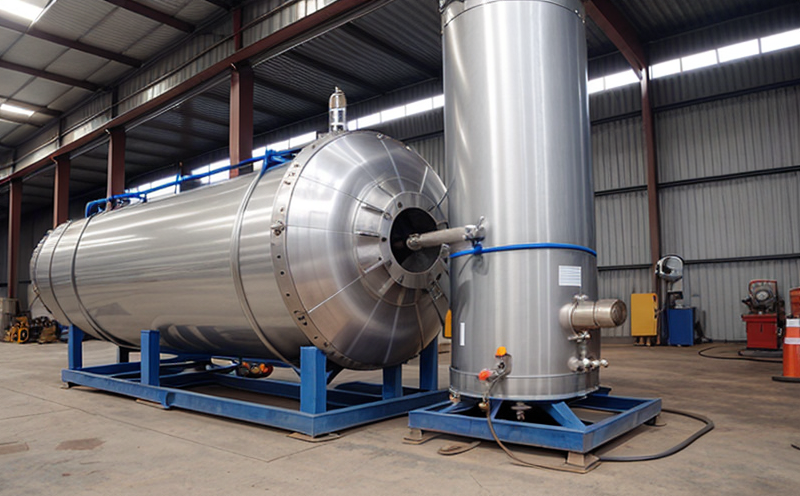Pressure vessel pneumatic pressure inspection
The pressure vessel pneumatic pressure inspection is a critical procedure used to ensure the integrity and safety of pressure vessels in various industrial sectors. This non-destructive testing method involves applying compressed air or another gas inside the vessel while monitoring for leaks, cracks, or other defects that could compromise its structural integrity.
This inspection technique is particularly advantageous because it allows for thorough examination without requiring disassembly, which can be time-consuming and costly. It adheres to international standards such as ISO 12136-1:2007 and ASME Section VIII Division II, ensuring that the procedure meets stringent quality benchmarks.
During this process, a controlled amount of air or gas is introduced into the pressure vessel under specified conditions. A qualified inspector then meticulously examines the vessel for any signs of leakage using specialized equipment. The method can detect even minute flaws and defects within the material structure of the vessel, making it an indispensable tool in quality assurance.
The pneumatic pressure inspection can be performed on various types of containers including storage tanks, reactors, heat exchangers, and other vessels that handle hazardous materials or gases under pressure. This ensures compliance with regulatory requirements set by authorities like the Occupational Safety and Health Administration (OSHA) and the Pipeline and Hazardous Materials Safety Administration (PHMSA).
In summary, this inspection method is essential for maintaining safety standards in industries where the integrity of pressure vessels plays a crucial role. By adhering to established protocols and utilizing advanced technology, this technique provides peace of mind regarding the reliability of equipment used daily.
Industry Applications
| Industry Sector | Pneumatic Pressure Inspection Usage |
|---|---|
| Aerospace | Ensuring safety and compliance in aircraft fuel tanks. |
| Chemical Processing | Detecting leaks in storage tanks for hazardous materials. |
| Petrochemical | Maintaining integrity of storage tanks for crude oil. |
| Pharmaceutical | Verifying the safety and reliability of process vessels. |
The pneumatic pressure inspection is widely used across multiple industries where pressure vessels are integral components. Aerospace companies rely on this technique to ensure the safety of fuel tanks, minimizing risks associated with transportation and storage. In chemical processing facilities, it helps maintain the integrity of large storage tanks for hazardous substances, preventing potential leaks that could lead to environmental contamination or accidents.
Petrochemical firms use pneumatic inspections to verify the structural soundness of vast storage tanks containing crude oil or refined petroleum products. For pharmaceutical manufacturers, this method ensures compliance with stringent regulations regarding process vessels used in drug manufacturing processes. By adhering to these rigorous inspection standards, industries can enhance operational efficiency while ensuring worker safety and environmental protection.
Environmental and Sustainability Contributions
The pneumatic pressure inspection plays a vital role in promoting sustainability by enhancing the reliability of pressure vessels across various sectors. Through regular inspections, potential issues are identified early on, preventing costly repairs or replacements down the line. This proactive approach not only extends the lifespan of equipment but also reduces waste and resource consumption associated with premature failures.
Furthermore, by ensuring that all vessels meet stringent safety standards, this inspection contributes to a safer working environment for employees who interact directly with these systems. Reduced downtime due to unexpected breakdowns translates into improved productivity levels within organizations. Additionally, minimizing leaks of volatile compounds or hazardous substances helps protect ecosystems from contamination, aligning with broader environmental goals.
Adhering to international standards such as ISO 12136-1:2007 and ASME Section VIII Division II further reinforces the commitment towards sustainable practices by setting clear guidelines for conducting inspections. Compliance with these norms ensures that the testing procedures remain consistent across different geographic regions, promoting fair competition among businesses operating globally.
In conclusion, through its ability to identify potential weaknesses early on and promote responsible maintenance practices, the pneumatic pressure inspection serves as a cornerstone in fostering sustainable development within industries reliant upon pressure vessels. Its role extends beyond mere compliance; it represents an investment in long-term success by safeguarding both people and planet.
Use Cases and Application Examples
- Aerospace: Inspecting fuel tanks for commercial aircraft to ensure safe operation during flight.
- Chemical Processing: Verifying the integrity of storage tanks containing hazardous materials before filling them with chemicals.
- Petrochemical: Ensuring compliance with regulations regarding the safety and reliability of storage tanks for crude oil and refined petroleum products.
- Pharmaceutical: Confirming that process vessels meet strict quality control requirements during drug manufacturing processes.
The pneumatic pressure inspection finds extensive application in maintaining the integrity of critical components within these diverse industries. For instance, aerospace firms use this method to inspect fuel tanks for commercial aircraft before each flight, ensuring safe and reliable operations. In chemical processing plants, it helps verify that storage tanks containing hazardous materials are free from leaks before being filled with chemicals.
Petrochemical companies rely on pneumatic inspections to ensure compliance with regulations regarding the safety and reliability of storage tanks for crude oil and refined petroleum products. Meanwhile, pharmaceutical manufacturers depend on this technique to confirm that process vessels meet strict quality control requirements during drug manufacturing processes.





